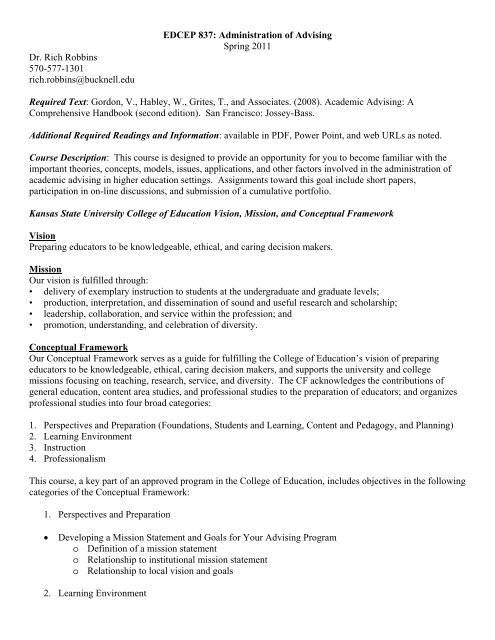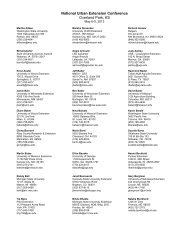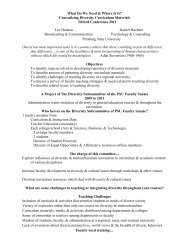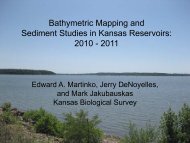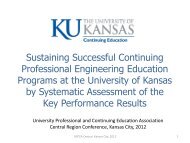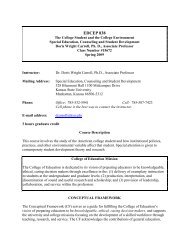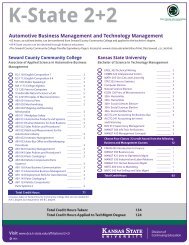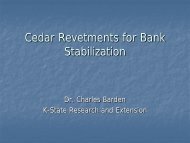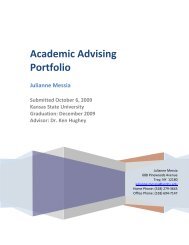Syllabus Sample - Kansas State University
Syllabus Sample - Kansas State University
Syllabus Sample - Kansas State University
Create successful ePaper yourself
Turn your PDF publications into a flip-book with our unique Google optimized e-Paper software.
Dr. Rich Robbins<br />
570-577-1301<br />
rich.robbins@bucknell.edu<br />
EDCEP 837: Administration of Advising<br />
Spring 2011<br />
Required Text: Gordon, V., Habley, W., Grites, T., and Associates. (2008). Academic Advising: A<br />
Comprehensive Handbook (second edition). San Francisco: Jossey-Bass.<br />
Additional Required Readings and Information: available in PDF, Power Point, and web URLs as noted.<br />
Course Description: This course is designed to provide an opportunity for you to become familiar with the<br />
important theories, concepts, models, issues, applications, and other factors involved in the administration of<br />
academic advising in higher education settings. Assignments toward this goal include short papers,<br />
participation in on-line discussions, and submission of a cumulative portfolio.<br />
<strong>Kansas</strong> <strong>State</strong> <strong>University</strong> College of Education Vision, Mission, and Conceptual Framework<br />
Vision<br />
Preparing educators to be knowledgeable, ethical, and caring decision makers.<br />
Mission<br />
Our vision is fulfilled through:<br />
• delivery of exemplary instruction to students at the undergraduate and graduate levels;<br />
• production, interpretation, and dissemination of sound and useful research and scholarship;<br />
• leadership, collaboration, and service within the profession; and<br />
• promotion, understanding, and celebration of diversity.<br />
Conceptual Framework<br />
Our Conceptual Framework serves as a guide for fulfilling the College of Education’s vision of preparing<br />
educators to be knowledgeable, ethical, caring decision makers, and supports the university and college<br />
missions focusing on teaching, research, service, and diversity. The CF acknowledges the contributions of<br />
general education, content area studies, and professional studies to the preparation of educators; and organizes<br />
professional studies into four broad categories:<br />
1. Perspectives and Preparation (Foundations, Students and Learning, Content and Pedagogy, and Planning)<br />
2. Learning Environment<br />
3. Instruction<br />
4. Professionalism<br />
This course, a key part of an approved program in the College of Education, includes objectives in the following<br />
categories of the Conceptual Framework:<br />
1. Perspectives and Preparation<br />
• Developing a Mission <strong>State</strong>ment and Goals for Your Advising Program<br />
o Definition of a mission statement<br />
o Relationship to institutional mission statement<br />
o Relationship to local vision and goals<br />
2. Learning Environment
• Delivery of Advising Services<br />
o Models<br />
o Advisor loads<br />
• Use of Technology in Advising<br />
o Different medias<br />
o Issues<br />
3. Instruction<br />
• Identifying Outcomes for Advising<br />
o Advisor/process/delivery outcomes<br />
o Student learning outcomes<br />
• Advisor Training and Development<br />
o Advising as teaching<br />
o Components of effective advising<br />
• Assessment of Advising Programs<br />
o Assessment versus evaluation<br />
o Key factors<br />
o Assessment process<br />
o Utilizing existing instruments and resources<br />
o Communication of results<br />
o Acting on results<br />
4. Professionalism<br />
• Legal and Ethical Issues<br />
o Moral, ethical, legal issues<br />
o FERPA<br />
o Working with parents<br />
o ADA<br />
o Working with students in distress<br />
• Financial Management of Your Program<br />
o Institutional issues: rules, regulations, policies<br />
o Funding resources<br />
• Campus Environment and Politics<br />
o Navigating the campus environment<br />
o Building connections<br />
Course Objectives: This course will provide information, discussion, and feedback regarding the following<br />
topics in the administration of academic advising in higher education:<br />
I. Developing a Mission <strong>State</strong>ment and Goals for Your Advising Program<br />
a. Definition of a mission statement<br />
b. Relationship to institutional mission statement<br />
c. Relationship to local vision and goals<br />
II. Identifying Outcomes for Advising
a. Advisor/process/delivery outcomes<br />
b. Student learning outcomes<br />
III. Delivery of Advising Services<br />
a. Models<br />
b. Advisor loads<br />
IV. Use of Technology in Advising<br />
a. Different medias<br />
b. Issues<br />
V. Advisor Training and Development<br />
a. Advising as teaching<br />
b. Components of effective advising<br />
VI. Advisor Evaluation, Reward and Recognition<br />
a. Evaluation versus assessment<br />
b. Methods of advisor evaluation<br />
c. Developing and advisor evaluation instrument<br />
d. Role of evaluation in reward and recognition<br />
e. Forms of reward<br />
f. Forms of recognition<br />
VII.<br />
Legal and Ethical Issues<br />
a. Moral, ethical, legal issues<br />
b. FERPA<br />
c. Working with parents<br />
d. ADA<br />
e. Working with students in distress<br />
VIII. Financial Management of Your Program<br />
a. Institutional issues: rules, regulations, policies<br />
b. Funding resources<br />
IX.<br />
Campus Environment and Politics<br />
a. Navigating the campus environment<br />
b. Building connections<br />
X. Assessment of Advising Programs<br />
a. Assessment versus evaluation<br />
b. Key factors<br />
c. Assessment process<br />
d. Utilizing existing instruments and resources<br />
e. Communication of results<br />
f. Acting on results<br />
Learning Outcomes: Students will demonstrate an understanding of the above listed course objectives via<br />
authoring of appropriate papers, adequate completion of additional assignments, sufficient participation in online<br />
discussions, and submission of a correct cumulative portfolio. At the completion of the course, students<br />
will have a clearly delineated administrative description of their respective advising programs, including<br />
identified issues and the start of an overall assessment paradigm for their programs.<br />
Grading: Grades will be based on the following:<br />
1) Papers: You are required to submit a total of six 1-2 page papers during the semester as noted on the<br />
schedule for a total of 120 possible points. These are short research papers, NOT reaction papers. One of the<br />
most important aspects of these papers is being able to answer the questions correctly, but concisely as well,<br />
referencing the appropriate resources in your text and other assigned materials and readings. Here are the<br />
instructions for the assigned papers:
1. All papers should be single-spaced, with 1” margins and Times Roman 12-point font.<br />
2. All papers must incorporate the assigned readings for the current Module. Information from or referring<br />
to any of the assigned readings, any course materials, or any other information considered an outside<br />
source must be cited appropriately in the text of the paper and a reference list must be included at the<br />
end of the paper.<br />
3. Referenced materials in the form of citations in the text and reference lists at the end should be in APA<br />
format. Teaching APA format is not part of the course. If you are unfamiliar with or need a refresher<br />
on APA format, please see the Purdue <strong>University</strong> APA site at<br />
http://owl.english.purdue.edu/owl/resource/560/01<br />
There is also an on-line tutorial on the APA website at<br />
http://www.apastyle.org/learn/tutorials/basics-tutorial.aspx<br />
4. If you cut-and-paste information from a web site, please format the text so there is one font throughout<br />
your paper. Be sure to cite the web site appropriately both in the text and on the reference list.<br />
5. Papers should be submitted in the format of a written paper. Please do not simply cut-and-paste a list of<br />
items or quotes from a web site as your paper, or answer specific parts of the assignment in separate<br />
responses. You need to include information and discuss in paragraph form that flows logically in the<br />
form of a paper.<br />
6. Be sure to answer ALL parts of the assignment in order to receive full credit.<br />
7. Please identify your papers by titling the files "Paper Module # last name" - for example: Paper Module<br />
1 Robbins. THIS IS VERY IMPORTANT AS YOUR READER WILL BE RECEIVING<br />
MULITIPLE PAPERS EACH ASSIGNMENT.<br />
8. Please submit your papers in Microsoft Word format with the extension .doc. No .docx files, please!<br />
9. Be sure to meet all deadlines as identified on the course syllabus in order to receive full credit for your<br />
papers. Papers may be submitted early, but are due no later than the date identified for each in the<br />
course syllabus. Papers handed in late will only be accepted for possible credit if submitted within 24<br />
hours/1 day of the original submission deadline. Any paper submitted late but within 24 hours/1 day of<br />
the original deadline will receive 1/2 the points it would have if graded normally - which means that<br />
even if the paper if perfect, the best a late paper can receive would be 10 points out of 20. No papers will<br />
be accepted after 24 hours/1 day of the original deadline; you will receive no points for the assignment if<br />
turned in any later or not turned in at all.<br />
10. Please see a sample paper posted in the module titled “<strong>Syllabus</strong> and <strong>Sample</strong> Paper.”<br />
11. Upon receipt of your graded paper, you should review the comments and feedback made via the Track<br />
Changes function of Microsoft Word. Since your final portfolio will consist primarily of your revised<br />
reaction papers, you should ideally incorporate the feedback and make revisions as appropriate as soon<br />
as you receive your graded paper to avoid a time-crunch at the end of the course when putting your<br />
portfolio together.<br />
Evaluation of papers is based on analyzing and synthesizing the reading, application of material to advising<br />
situation and role, and correct use of language and mechanics. Each paper is worth 20 points for a total of 140<br />
possible points. Papers must be submitted by midnight (your time) of the due date; all due dates will be<br />
on a Monday to allow at least one full weekend to work on the assignment. Papers may be submitted early,<br />
but are due no later than the date identified for each on the course syllabus.
2) Additional Assignments: Module 6 includes an assignment in addition to the assigned paper worth 20<br />
points, while the assignment for Module 7 is not a paper but a different assignment worth 20 points.<br />
3) Discussion and Response Postings: Students are required to post comments and responses to the Discussion<br />
Board on topics for each of the 7 modules. Students are required to post at least one response to the instructor’s<br />
question, and are also required to post at least one response, comment, and/or question to a fellow student's<br />
comment or response. You may respond as much as you would like but must meet the criteria above. All<br />
responses will be due by midnight (your local time) on a Friday prior the due date for your assigned<br />
paper in order to allow you to incorporate relevant information from the discussion board into your<br />
paper. You will receive 10 points for each posting – therefore a total of 20 points for each assigned discussion<br />
board topic – for a total of 140 possible points. There are no post-deadline responses allowed for the<br />
discussion.<br />
PLEASE NOTE: the assigned papers and discussion questions require you to apply information from<br />
your course assignments to the administration of academic advising at an institution of higher education.<br />
If you are not currently in an administrative academic advising or related position at an institution, you<br />
should identify an institution with which you are either familiar or can easily access their administration<br />
of academic advising information. This may require you to make personal contact with an academic<br />
advising administrator to serve as a resource for the course. By formally identifying an institution and<br />
utilizing that school's information throughout this course, you will become more familiar with foundation<br />
and practice of the administration of academic advising, and higher education practices in general, than<br />
if the questions were answered hypothetically.<br />
4) Submission of a Cumulative Portfolio: At the completion of the course, students will have a clearly<br />
delineated administrative description of their respective advising programs, including identified issues and the<br />
start of an overall assessment paradigm for their programs. The final portfolio will be a culmination of all of<br />
the readings, assignments, and other aspects of the course and will be worth 100 points. Detailed directions for<br />
the final portfolio can be found below.<br />
Total possible points = 390<br />
A = 351 - 390 points<br />
B = 312 - 350 points<br />
C = 273 - 311 points<br />
D = 234 - 272 points<br />
PLEASE NOTE: Instructions and deadlines for all graded assignments and activities are listed below.<br />
There is no extra credit opportunity for this course.<br />
Module 1. Developing a Mission <strong>State</strong>ment and Goals for Your Advising Program<br />
Campbell, S. M. (2008). Vision, Mission, Goals, and Program Objectives for Academic Advising Programs. In<br />
V. Gordon, W. Habley, and T. Grites (Eds.) Academic Advising: A Comprehensive Handbook (2 nd edition),<br />
chapter 14.<br />
Habley, W. R. (2005). Developing a mission statement for the academic advising program. NACADA<br />
Clearinghouse of Academic Advising Resources. www.nacada.ksu.edu/Clearinghouse/AdvisingIssues/Mission-<br />
<strong>State</strong>ments..html<br />
Paper Assignment: In a 1-2 page paper –<br />
• Delineate your institutional mission statement
• Delineate your local mission statement (if you have one)<br />
• If you do not have a local mission statement, develop a tentative one for purposes of this course<br />
• Delineate your programmatic goals for the academic advising of your students<br />
• If you do not have clearly identified programmatic goals, develop several tentative ones for purposes of<br />
this course<br />
• Identify/track how your local mission statement relates back to your institutional mission and forward to<br />
your programmatic goals<br />
Paper for Module 1 is due by midnight (your time) on Monday, January 31, 2011<br />
*Be sure to submit your responses to the Module 1 discussion board topic by midnight (your time) Friday,<br />
January 28, 2011<br />
Module 2. Identifying Outcomes for Advising<br />
Schuh, J. H. (2008). Assessing Student Learning. In V. Gordon, W. Habley, and T. Grites (Eds.) Academic<br />
Advising: A Comprehensive Handbook (2 nd edition), chapter 23.<br />
Robbins, R. L. (2009). Evaluation and assessment of career advising. In K. Hughey, D. N. Burton Nelson, J.<br />
Damminger, and B. McCalla-Wriggins (Eds.) The Handbook of Career Advising (chapter 12). San Francisco:<br />
Jossey-Bass. (pages 268-271 of .pdf)<br />
View Power Point presentation #1: “Advising Outcomes”<br />
Paper Assignment: Based on your local mission and goals (as identified in Module 1) and the information<br />
provided in the reading and Power Point presentation –<br />
• Identify two process/delivery outcomes for your advising program and at least two outcome measures<br />
for each<br />
• Identify two student learning outcomes for your advising program and at least two outcome measures<br />
for each<br />
Assignment for Module 2 is due by midnight (your time) on Monday, February 14, 2011<br />
*Be sure to submit your responses to the Module 2 discussion board topic by midnight (your time) Friday,<br />
February 11, 2011<br />
Module 3. Delivery of Academic Advising<br />
King, M. C. (2008). Organization of Academic Advising Services. In V. Gordon, W. Habley, and T. Grites<br />
(Eds.) Academic Advising: A Comprehensive Handbook (2 nd edition), chapter 15.<br />
Hemwall, M. K. (2008). Advising Delivery: Faculty. In V. Gordon, W. Habley, and T. Grites (Eds.) Academic<br />
Advising: A Comprehensive Handbook (2 nd edition), chapter 16.<br />
Self, C. (2008). Advising Delivery: Professional Advisors, Counselors, and Other Staff. In V. Gordon, W.<br />
Habley, and T. Grites (Eds.) Academic Advising: A Comprehensive Handbook (2 nd edition), chapter 17.<br />
King, N. S. (2008). Advising Delivery: Group Strategies. In V. Gordon, W. Habley, and T. Grites (Eds.)<br />
Academic Advising: A Comprehensive Handbook (2 nd edition), chapter 18.
Habley, W. R. (2004). Advisor load. NACADA Clearinghouse of Academic Advising Resources.<br />
www.nacada.ksu.edu/Clearinghouse/AdvisingIssues/advisorload.htm<br />
Leonard, M. J. (2008). Advising Delivery: Using Technology. In V. Gordon, W. Habley, and T. Grites (Eds.)<br />
Academic Advising: A Comprehensive Handbook (2 nd edition), chapter 19.<br />
Carter, J. (2007). Utilizing Technology in Academic Advising. NACADA Clearinghouse of Academic Advising<br />
Resources. http://www.nacada.ksu.edu/Clearinghouse/AdvisingIssues/Technology.htm<br />
Multari, R. J. (2004). The Economics of Technology in Advisement Services.<br />
http://www.psu.edu/dus/mentor/040826rm.htm<br />
Steele, G. (2005). Distance advising. NACADA Clearinghouse of Academic Advising Resources.<br />
http://www.nacada.ksu.edu/Clearinghouse/AdvisingIssues/adv_distance.htm<br />
View Power Point #2: “Delivery of Advising: Models and Systems”<br />
Paper Assignment: In a 1-2 page paper –<br />
• Identify your current advising model, advising loads, and delivery methods of advising<br />
• Relate the specific model(s), advising loads, and delivery method(s) to the assigned readings, including<br />
the positive and negative aspects of each<br />
• Identify and discuss the current technologies used on your campus to deliver academic advising; be sure<br />
to identify both the positive and negative aspects of these technologies<br />
Paper for Module 3 is due by midnight (your time) on Monday, February 28, 2011<br />
*Be sure to submit your responses to the Module 3 discussion board topic by midnight (your time) Friday,<br />
February 25, 2011<br />
Module 4. Advisor Training, Evaluation, Reward, and Recognition<br />
Appleby, D. C. (2008). Advising as Teaching and Learning. In V. Gordon, W. Habley, and T. Grites (Eds.)<br />
Academic Advising: A Comprehensive Handbook (2 nd edition), chapter 6.<br />
Brown, T. (2008). Critical Concepts in Advisor Training and Development. In V. Gordon, W. Habley, and T.<br />
Grites (Eds.) Academic Advising: A Comprehensive Handbook (2 nd edition), chapter 20.<br />
Drake, J. K. (2008). Recognition and Reward for Academic Advising in Theory and Practice. In V. Gordon,<br />
W. Habley, and T. Grites (Eds.) Academic Advising: A Comprehensive Handbook (2 nd edition), chapter 26.<br />
Folsom, P. (2008). Tools and Resources for Advisors. In V. Gordon, W. Habley, and T. Grites (Eds.)<br />
Academic Advising: A Comprehensive Handbook (2 nd edition), chapter 21.<br />
Fox, R. (2008). Delivering One-to-One Advising: Skills and Competencies. In V. Gordon, W. Habley, and T.<br />
Grites (Eds.) Academic Advising: A Comprehensive Handbook (2 nd edition), chapter 22.<br />
View Power Point presentation #3: “Advisor Training and Development”<br />
View Power Point presentation #4: “Advisor Evaluation”
Paper Assignment: In a 1-2 page paper –<br />
• Describe the advisor development/training that occurs in your program and on your campus; relate your<br />
respective advisor development/training practices to the assigned readings and information from the<br />
Power Point presentation<br />
• Describe the advisor evaluation practices that occur in your program and on your campus; relate your<br />
respective advisor evaluation practices to the assigned readings and information from the Power Point<br />
presentation<br />
• Describe the advisor reward and recognition practices that occur in your program and on your campus;<br />
relate your respective advisor reward and recognition practices to the assigned readings and information<br />
from the Power Point presentation<br />
• As an advising administrator, describe your ideal structure for advisor training and development,<br />
evaluation, reward and recognition in your program<br />
Paper for Module 4 is due by midnight (your time) on Monday, March 14, 2011<br />
*Be sure to submit your responses to the Module 4 discussion board topic by midnight (your time) Friday,<br />
March 11, 2011<br />
Module 5. Legal and Ethical Issues<br />
Lowenstein, M. (2008). Ethical Foundations of Academic Advising. In V. Gordon, W. Habley, and T. Grites<br />
(Eds.) Academic Advising: A Comprehensive Handbook (2 nd edition), chapter 3.<br />
Richard, M. M. (2008). Legal Foundations of Academic Advising. In V. Gordon, W. Habley, and T. Grites<br />
(Eds.) Academic Advising: A Comprehensive Handbook (2 nd edition), chapter 4.<br />
Fisher, K. (2005). Ethical decision making in academic advising. NACADA Clearinghouse of Academic<br />
Advising Resources. www.nacada.ksu.edu/Clearinghouse/AdvisingIssues/Ethical-Decisions.htm<br />
Robinson, S. (2004). Legal issues for advisors: A primer. NACADA Clearinghouse of Academic Advising<br />
Resources. www.nacada.ksu.edu/Clearinghouse/AdvisingIssues/legal.htm<br />
Van Dusen, William R., Jr. (2004). FERPA: Basic guidelines for faculty and staff a simple step-by-step<br />
approach for compliance. www.nacada.ksu.edu/Resources/FERPA-Overview.htm<br />
Family Educational Right to Privacy Act (FERPA). www.ed.gov/policy/gen/guid/fpco/ferpa/index.html<br />
Kepic, G. (2005). Causes and Implications of Parental Involvement in the Advising process. NACADA<br />
Clearinghouse of Academic Advising Resources. www.nacada.ksu.edu/clearinghouse/AdvisingIssues/Parental-<br />
Involvement.htm<br />
Menezes, M. D. (2005). Advisors and parents: Together building stronger advising relationships. NACADA<br />
Clearinghouse of Academic Advising Resources.<br />
www.nacada.ksu.edu/Clearinghouse/AdvisingIssues/Advisors-Parents.htm<br />
Stack, C. (2003). Talking with the parents of advisees. The Mentor : An Academic<br />
Advising Journal. www.psu.edu/dus/mentor/030714cs.htm<br />
Americans with Disabilities Act. www.eeoc.gov/policy/ada.html
Harper, R. & Peterson, M. (2005). Mental health issues and college students. NACADA Clearinghouse of<br />
Academic Advising Resources. www.nacada.ksu.edu/Clearinghouse/AdvisingIssues/Mental-Health.htm<br />
View Power Point #5: “Working with Parents”<br />
View Power Point #6: “Working with Students in Emotional Crisis”<br />
Paper Assignment: In a 1-2 page paper –<br />
• Describe and discuss an ethical or legal issue you as an advising administrator have experienced relevant<br />
to academic advising on your campus, involving parents, FERPA, students with disabilities, and/or<br />
students in distress, describing:<br />
o The situation and issues<br />
o How you dealt with it<br />
o How the situation/issue and your response to it relates to the assigned readings and/or Power<br />
Point presentations<br />
Paper for module 5 is due by midnight (your time) on Monday, March 28, 2011<br />
*Be sure to submit your responses to the Module 5 discussion board topic by midnight (your time) Friday,<br />
March 25, 2011<br />
Module 6. Campus Environment, Campus Politics, and Funding<br />
Advising Administrators’ Tips for Dealing with Funding Reductions. NACADA Clearinghouse of Academic<br />
Advising Resources. www.nacada.ksu.edu/Clearinghouse/admintips.html<br />
Bultman, J. E., Vowell, F. N., Harney, J. Y., Smarrelli, J., & Ames, S. (2008). Campus Administrator<br />
Perspectives on Advising. In V. Gordon, W. Habley, and T. Grites (Eds.) Academic Advising: A<br />
Comprehensive Handbook (2 nd edition), chapter 27.<br />
Davis, K. J., Vallandingham, D., & Christman, P. D. (2008). Advising Administrator Perspectives on Advising.<br />
In V. Gordon, W. Habley, and T. Grites (Eds.) Academic Advising: A Comprehensive Handbook (2 nd edition),<br />
chapter 28.<br />
Funding Suggestions to Stretch Your Budget. NACADA Clearinghouse of Academic Advising Resources.<br />
www.nacada.ksu.edu/Clearinghouse/AdvisingIssues/Funding.htm<br />
Grites, T. (2003). Determining the worth of an advising unit. The Academic Advising News, 26 (1).<br />
www.nacada.ksu.edu/Clearinghouse/AdvisingIssues/worth.htm<br />
View Power Point #7: “Advising and the Campus Environment”<br />
View Power Point #8: “The Cost of Attrition: An Economic Formula”<br />
Paper Assignment: In a 1-2 page paper –<br />
• Identify the stakeholders for your academic advising program<br />
• Identify protagonists/supporters and antagonists/detractors<br />
• Discuss how you, as an advising administrator, would include all of the above parties in gaining support<br />
for your program
Additional Assignment:<br />
• Calculate the general worth of your advising program based on the Grites (2003) reading or calculate the<br />
cost of attrition for your institution as per Power Point #8<br />
Both the Paper and the Additional Assignment for module 6 are due by midnight (your time) on Monday, April<br />
11, 2011<br />
*Be sure to submit your responses to the Module 6 discussion board topic by midnight (your time) Friday, April<br />
8, 2011<br />
Module 7. Assessment of Academic Advising<br />
Robbins, R. L. (2009). Evaluation and assessment of career advising. In K. Hughey, D. N. Burton Nelson, J.<br />
Damminger, and B. McCalla-Wriggins (Eds.) The Handbook of Career Advising (chapter 12). San Francisco:<br />
Jossey-Bass. (pages 280-285; tables 12.1, 12.2, and 12.3; pages 289-290 of .pdf file)<br />
National Academic Advising Association. (2006). NACADA concept of academic advising.<br />
http://www.nacada.ksu.edu/Clearinghouse/AdvisingIssues/Concept-advising-introduction.htm<br />
NACADA Core Values (4 parts)<br />
NACADA. (2004). NACADA statement of core values of academic advising. From the NACADA<br />
Clearinghouse of Academic Advising Resources Web site:<br />
http://www.nacada.ksu.edu/Clearinghouse/AdvisingIssues/Core-Values.htm<br />
NACADA. (2004). NACADA statement of core values of academic advising: Introduction, From the NACADA<br />
Clearinghouse of Academic Advising Resources Web site:<br />
http://www.nacada.ksu.edu/Clearinghouse/AdvisingIssues/Core-Values-Introduction.htm<br />
NACADA. (2004). NACADA statement of core values of academic advising; Declaration. From the NACADA<br />
Clearinghouse of Academic Advising Resources Web site:<br />
http://www.nacada.ksu.edu/Clearinghouse/AdvisingIssues/Core-Values-Declaration.htm<br />
NACADA. (2004). NACADA statement of core values of academic advising: Exposition. From the NACADA<br />
Clearinghouse of Academic Advising Resources Web site:<br />
http://www.nacada.ksu.edu/Clearinghouse/AdvisingIssues/Core-Values-Exposition.htm<br />
Council for the Advancement of Standards in Higher Education (CAS) Standards and Guidelines for Advising.<br />
NACADA Clearinghouse of Academic Advising Resources.<br />
www.nacada.ksu.edu/Clearinghouse/Research_Related/CASStandardsForAdvising.pdf<br />
View Power Point #9: “Assessment of Academic Advising”<br />
Assignment: Complete the appropriate assessment matrices (process/delivery outcomes assessment and student<br />
learning outcomes assessment) utilizing the following as outcomes and identifying two measures for each –<br />
• Two CAS Standards for Advising which are relevant to your program (one process/delivery outcome<br />
and one student learning outcome)<br />
• The two process/delivery outcomes and relevant measures identified in Module 2
• The two student learning outcomes and relevant measures identified in Module 2<br />
NOTE: be sure to use just one process/delivery outcome assessment matrix and just one student learning<br />
outcomes matrix and complete each listing all of the appropriate outcomes and measures from the above - you<br />
will have one process/delivery outcomes matrix with three different process/delivery outcomes, measures, etc.<br />
identified, and one student learning outcomes matrix with three different student learning outcomes, measures,<br />
etc. identified<br />
Assignment for Module 7 is due by midnight (your time) on Monday, April 25, 2011<br />
*Be sure to submit your responses to the discussion board topic by midnight (your time) Friday, April 22, 2011<br />
Final Portfolio<br />
Develop a final portfolio consisting of all papers and assignments, arranged by Modules 1 through 7<br />
corresponding to each Module as titled above. This will require that you incorporate feedback and suggestions<br />
from each section’s respective paper assignments and discussion board discussions into a final cumulative<br />
portfolio. As such, it will provide you with the opportunity to arrange your individual administrative description<br />
of your specific advising program in a complete and final format for future use.<br />
Your final portfolios are due to your reader in WORD format no later than midnight (your time) Friday, May<br />
13, 2011. For each section included in the portfolio, it is expected that you will consider and incorporate all<br />
feedback given on your module papers and other graded assignments, and any additional information you deem<br />
important from the discussion questions to be included in the revisions of your module papers and assignments.<br />
Your revised module papers and assignments will constitute the bulk of your portfolio.<br />
Revised individual papers should be provided in the Track Changes format, with your original text,<br />
reviewer’s comments and suggested revisions, and your final revisions clearly discernable.<br />
You CANNOT use the “Cut-and-Paste” function of Word to do this, as that function loses the “Track<br />
Changes” feedback. You need to use the “Insert Text” command if you use Word 2003, or the “Insert File”<br />
function if you use Word 2007. If you are not familiar with these functions, you should access the “Help”<br />
function of your Word program to learn how to use it.<br />
Here are the directions for inserting a file into another file. Please note that for Word 2007 you cannot<br />
simply "insert file":<br />
Word 2003<br />
Click on the Insert menu<br />
Click on File (you may have to expand the menu list to see this option) Locate the file you wish to insert<br />
Double-click to insert<br />
Word 2007<br />
Click on the Insert tab<br />
Click on the arrow next to Object (on the far right) Click on Text from File Locate the file you wish to<br />
insert Double-click to insert<br />
This function will allow you to insert all of your individual files into one large cumulative file. You will<br />
need to make sure you watch for blank pages and page endings, although those shouldn't be too much of<br />
an issue.
If you are using Word 2010, you will need to refer to your user guide and help function as I am unaware<br />
of how to merge files in that version.<br />
The portfolio should consist of 8 sections, with the first 7 corresponding to the individual module of the course<br />
and the last being a final reflection consisting of a paragraph or two regarding your final thoughts about the<br />
course - what you have learned, what made the biggest impact on you, how you may use the knowledge gained,<br />
etc. (see “Final reflection” below).<br />
I. Mission, Goals, and Outcomes for Academic Advising<br />
II. Identifying Outcomes for Advising<br />
III. Delivery of Academic Advising<br />
IV. Advisor Training, Evaluation, Reward, and Recognition<br />
V. Legal and Ethical Issues<br />
VI. Campus Environment, Campus Politics, and Funding<br />
VII. Assessment of Academic Advising<br />
VIII. Final Reflections<br />
Final Reflection<br />
In a one-page response, please discuss what you have learned from the course, what information or material<br />
learned made the biggest impact on you, how you feel you will use the knowledge gained in your professional<br />
career.<br />
The portfolio should be submitted as one document, with the section title on a separate title page prior to the<br />
materials for each respective section. All that is required to be in each section of the final portfolio is the<br />
revised reaction paper and any additional revised assignments from each respective section of the course,<br />
along with your final reflection.<br />
Don’t over-think the final portfolio! The idea is for you to have a final and complete document incorporating<br />
all of the work you have done during the semester. It is designed to be a relatively easy way to get a lot of<br />
points at the end of the semester as well.<br />
Be sure to submit your portfolio no later than Friday, May 13, 2011.


